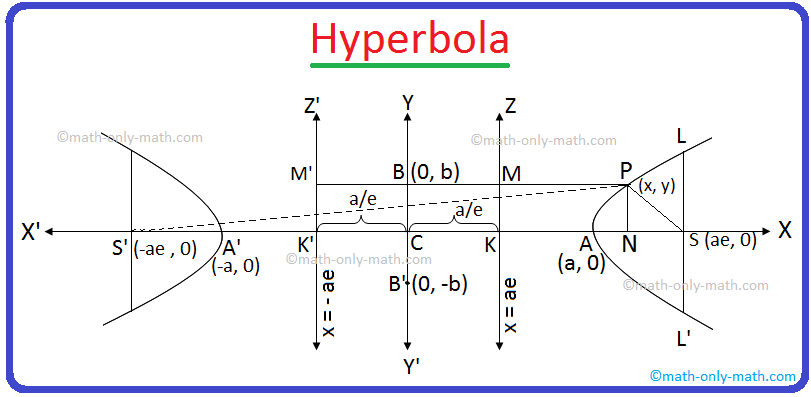Latus Rectum of the Hyperbola
We will discuss about the latus rectum of the hyperbola along with the examples.
Definition of the Latus Rectum of the Hyperbola:
The chord of the hyperbola through its one focus and perpendicular to the transverse axis (or parallel to the directrix) is called the latus rectum of the hyperbola.
It is a double ordinate passing through the focus. Suppose the equation of the hyperbola be x2a2 - y2b2 = 1 then, from the above figure we observe that L1SL2 is the latus rectum and L1S is called the semi-latus rectum. Again we see that M1SM2 is also another latus rectum.
According to the diagram, the co-ordinates of the
end L1 of the latus
rectum L1SL2 are (ae,
SL1). As L1 lies on the hyperbola x2a2 - y2b2 = 1, therefore, we
get,
(ae)2a2 - (SL1)2b2 = 1
a2e2a2 - (SL1)2b2 = 1
e2 - (SL1)2b2 =
1
⇒ (SL1)2b2 = e2 - 1
⇒ SL12 = b2 . b2a2, [Since, we know that, b2 = a2(e2−1)]
⇒ SL12 = b4a2
Hence, SL1 = ± b2a.
Therefore, the co-ordinates of the ends L1 and L2 are (ae, b2a) and (ae, - b2a) respectively and the length of latus rectum = L1SL2 = 2 . SL1 = 2 . b2a = 2a(e2−1)
Notes:
(i) The equations of the latera recta of the hyperbola x2a2 - y2b2 = 1 are x = ± ae.
(ii) A hyperbola has two latus rectum.
Solved examples to find the length of the latus rectum of a hyperbola:
Find the length of the latus rectum and equation of the latus rectum of the hyperbola x2 - 4y2 + 2x - 16y - 19 = 0.
Solution:
The given equation of the hyperbola x2 - 4y2 + 2x - 16y - 19 = 0
Now form the above equation we get,
(x2 + 2x + 1) - 4(y2 + 4y + 4) = 4
⇒ (x + 1)2 - 4(y + 2)2 = 4.
Now dividing both sides by 4
⇒ (x+1)24 - (y + 2)2 = 1.
⇒ (x+1)222−(y+2)212 ………………. (i)
Shifting the origin at (-1, -2) without rotating the coordinate axes and denoting the new coordinates with respect to the new axes by X and Y, we have
x = X - 1 and y = Y - 2 ………………. (ii)
Using these relations, equation (i) reduces to X222 - Y212 = 1 ………………. (iii)
This is of the form X2a2 - Y2b2 = 1, where a = 2 and b = 1.
Thus, the given equation represents a hyperbola.
Clearly, a > b. So, the given equation represents a hyperbola whose tranverse and conjugate axes are along X and Y axes respectively.
Now fine the eccentricity of the hyperbola:
We know that e = √1+b2a2 = √1+1222 = √1+14 = √52.
Therefore, the length of the latus rectum = 2b2a = 2∙(1)22 = 22 = 1.
The equations of the latus recta with respect to the new axes are X = ±ae
X = ± 2 ∙ √52
⇒ X = ± √5
Hence, the equations of the latus recta with respect to the old axes are
x = ±√5 – 1, [Putting X = ± √5 in (ii)]
i.e., x = √5 - 1 and x = -√5 – 1.
● The Hyperbola
- Definition of Hyperbola
- Standard Equation of an Hyperbola
- Vertex of the Hyperbola
- Centre of the Hyperbola
- Transverse and Conjugate Axis of the Hyperbola
- Two Foci and Two Directrices of the Hyperbola
- Latus Rectum of the Hyperbola
- Position of a Point with Respect to the Hyperbola
- Conjugate Hyperbola
- Rectangular Hyperbola
- Parametric Equation of the Hyperbola
- Hyperbola Formulae
- Problems on Hyperbola
11 and 12 Grade Math
From Latus Rectum of the Hyperbola to HOME PAGE
Didn't find what you were looking for? Or want to know more information about Math Only Math. Use this Google Search to find what you need.
Recent Articles
-
Word Problems on Multiplication and Division of Fractions | Worksheet
Apr 13, 25 10:09 AM
Here we will solve different types of word problems on multiplication and division of fractions. I. Solve the following word problems on multiplication of fractions. -
One More than Numbers upto 10 | Counting One More | Learn 1 more Than
Apr 11, 25 04:09 PM
1 more than means we need to add or count one more number to the given numbers. Here, we will learn counting one more than upto number 10. Examples of counting 1 more than up to number 10 are given as… -
One Less than Numbers upto 10 | Counting One Less | Learn 1 Less Than
Apr 11, 25 04:07 PM
What is one less than? 1 less than means we need to subtract or count one less number of the given numbers. Here, we will learn counting one less than upto number 10. Examples of counting 1 less than… -
Properties of Multiplication and Division of Fractions Worksheet | Ans
Apr 10, 25 03:17 PM
In properties of multiplication and division of fractions worksheet you will get different types of questions based on properties of multiplication of fractional numbers and properties of division of… -
Word Problems on Fraction | Math Fraction Word Problems |Fraction Math
Apr 09, 25 01:44 AM
In word problems on fraction we will solve different types of problems on multiplication of fractional numbers and division of fractional numbers.




New! Comments
Have your say about what you just read! Leave me a comment in the box below. Ask a Question or Answer a Question.